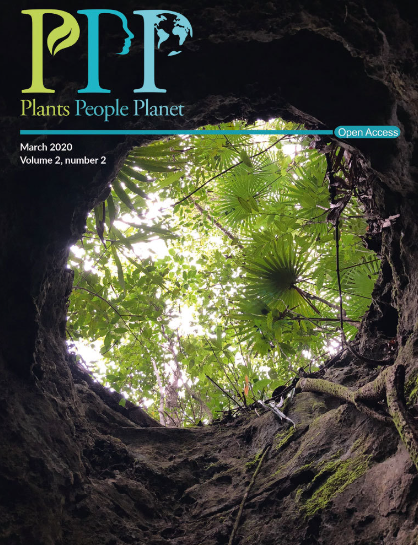Can seed exchange networks explain the morphological and genetic diversity in perennial crop species? The case of the tropical fruit tree Dacryodes edulis in rural and urban Cameroon
IF 3.6
2区 环境科学与生态学
Q1 BIODIVERSITY CONSERVATION
引用次数: 0
Abstract
Societal Impact Statement Crop seed exchange networks, shaped by social dynamics, strongly influence the organization and breadth of plant diversity in human‐managed environments. Integrating an urban and market perspective, this study explores the diversity dynamics of a socio‐economically important Central African fruit tree species, the African plum tree. Tree owners in urban, peri‐urban and rural sites use seeds from different origins as their main propagation material, leading to locational variations in genetic diversity and structure. This analysis contributes toward building a framework to inform the research agenda of cultivated African fruit trees, by highlighting the important role of urban centers in safeguarding crop genetic resources. Summary Biocultural factors constrain the dynamics of crop species diversity. Here, we considered different aspects of the social, spatial and temporal dynamics of morphological and genetic diversity in a multi‐purpose perennial crop, the African plum tree ( Dacryodes edulis ). We assessed (i) how seed exchange networks were organized along urbanization gradients, and how they influenced the distribution of species diversity; (ii) the temporal dynamic of seed exchange network by characterizing species genetic diversity through time. To do so, the study was carried out in Cameroon, where we focused on three urbanization gradients, covering urban, peri‐urban and rural areas, corresponding to three different ethnic groups (Bamileke, Bassa, Beti). We combined interviews with tree owners and nuclear microsatellite‐based genetic analyses. Tree owners from urban and peri‐urban sites primarily used distant seed sources, acquired in the market or from their village of origin, as propagation material, whereas tree owners in rural sites relied primarily on village‐level seeds. In turn, genetic diversity was not evenly distributed, with rural sites exhibiting their own genetic clusters. On the contrary, the genetic diversity of urban sites was enhanced by extensive human‐mediated seed flows. Looking at trees from different age classes, we found that genetic diversity was stable over time. Overall, this first attempt to combine different levels of diversity for African plum trees in commercially connected areas expands the scope for in situ intraspecific conservation by highlighting the contribution of urbanized areas.种子交换网络能否解释多年生作物物种的形态和遗传多样性?喀麦隆农村和城市热带果树的案例
作物种子交换网络受社会动态的影响,强烈影响人类管理环境中植物多样性的组织和广度。结合城市和市场的视角,本研究探讨了中非一种重要的社会经济果树——非洲李树的多样性动态。城市、城郊和农村地区的树木所有者使用不同来源的种子作为主要繁殖材料,导致遗传多样性和结构的地域差异。该分析强调了城市中心在保护作物遗传资源方面的重要作用,有助于建立一个框架,为非洲栽培果树的研究议程提供信息。生物栽培因素制约着作物物种多样性的动态变化。本文研究了多年生作物非洲李树(Dacryodes edulis)形态和遗传多样性的社会、空间和时间动态。我们评估了(i)种子交换网络是如何沿着城市化梯度组织的,以及它们如何影响物种多样性的分布;(2)种子交换网络的时间动态特征。为此,我们在喀麦隆开展了这项研究,重点研究了三个城市化梯度,涵盖城市、近郊和农村地区,对应三个不同的民族(巴米莱克、巴萨、贝蒂)。我们结合了与树木所有者的访谈和基于核微卫星的遗传分析。城市和城郊地区的树木所有者主要使用从市场或原产村庄获得的遥远种子来源作为繁殖材料,而农村地区的树木所有者主要依靠村庄一级的种子。反过来,遗传多样性分布不均匀,农村地区表现出自己的遗传集群。相反,广泛的人类介导的种子流动增强了城市遗址的遗传多样性。观察不同年龄段的树木,我们发现遗传多样性随着时间的推移是稳定的。总的来说,这是第一次尝试将非洲李树在商业联系地区的不同水平的多样性结合起来,通过突出城市化地区的贡献,扩大了原地种内保护的范围。
本文章由计算机程序翻译,如有差异,请以英文原文为准。
求助全文
约1分钟内获得全文
求助全文
来源期刊

Plants People Planet
Multiple-
CiteScore
9.90
自引率
5.90%
发文量
81
审稿时长
12 weeks
期刊介绍:
Plants, People, Planet aims to publish outstanding research across the plant sciences, placing it firmly within the context of its wider relevance to people, society and the planet. We encourage scientists to consider carefully the potential impact of their research on people’s daily lives, on society, and on the world in which we live. We welcome submissions from all areas of plant sciences, from ecosystem studies to molecular genetics, and particularly encourage interdisciplinary studies, for instance within the social and medical sciences and chemistry and engineering.
 求助内容:
求助内容: 应助结果提醒方式:
应助结果提醒方式:


